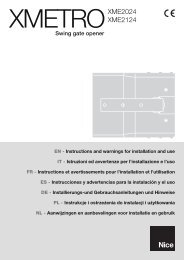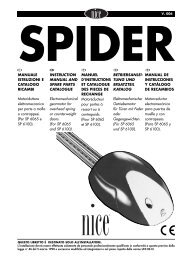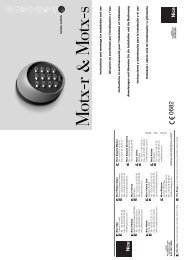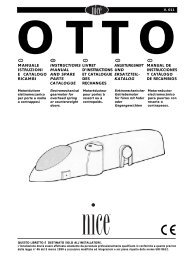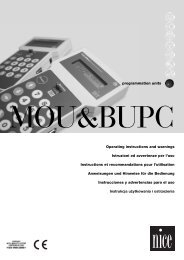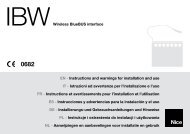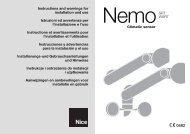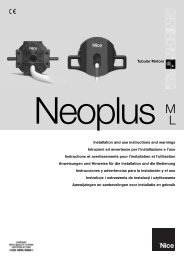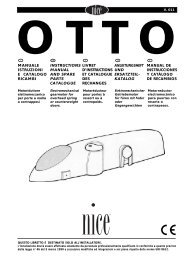You also want an ePaper? Increase the reach of your titles
YUMPU automatically turns print PDFs into web optimized ePapers that Google loves.
2) Product description and intended use<br />
4<br />
TEN (figure 1) is a gearmotor for the automation of counterweight up-and-over doors, spring up-and-over doors, projecting, non- projecting,<br />
and articulated. TEN is fitted with an electronic limit switch system with absolute encoder to enable constant detection of the motor position,<br />
even when the door is released for manual manoeuvres. It is able to reach the travel limit (opening and closing) through a deceleration phase.<br />
It also ensures constant control of the force required during manoeuvres, detecting any anomalies, such as a sudden obstacle that blocks<br />
leaf movement; in this case the automation executes a stop with brief inversion of movement.<br />
Table 1: Description of TEN <strong>com</strong>position<br />
Model DESCRIPTION<br />
TN2010 Irreversible gearmotor, control unit, electronic limit switch via absolute encoder and courtesy light.<br />
TN2020 Irreversible gearmotor and courtesy light. To be used as “Slave” of TN2010 or TN2020<br />
* If used in other configurations, ensure that the power supply is from a very low voltage safety system in which voltages never exceed the established<br />
low voltage safety limits.<br />
1<br />
Before proceeding with installation, check the condition of the product <strong>com</strong>ponents,<br />
suitability of the selected model and conditions of the intended installation<br />
environment.<br />
2.1) Limits of use<br />
Data related to the performance of TEN are provided in chapter “8 Technical specifications” and are the only values that enable correct evaluation<br />
of the suitability of application. In general TEN can automate up-and-over doors within the limits stated in Table 2.<br />
Table 2: Limits of use for TEN gearmotors<br />
Door type Power operated with 1 motor Power operated with 2 motors<br />
Projecting up-and-over door Max. height 2.6 m Max. length 3m Max. height 2.6 m Max. length 5.4 m<br />
Non-projecting up-and-over door Max. height 2.6 m Max. length 3m Max. height 2.6 m Max. length 5.4m<br />
The measurements in table 2 are guideline only for general estimate purposes. The effective suitability of TEN for automation of a specific door<br />
depends on the degree of leaf balancing, friction on tracks and other factors, also occasional, such as wind pressure or the presence of ice,<br />
which may obstruct leaf movement. To ensure feasibility, it is absolutely indispensable to measure the force required to move the door throughout<br />
travel and to check that this never exceeds the “nominal torque” as specified in Chapter “8 Technical specifications”; it is also important to<br />
establish the number of cycles per hour and consecutive cycles admissible, with reference to Table 3 and Table 4<br />
Table 3: Limits in relation to the force required to move the leaf with 1 TN2010<br />
Force required to move leaf (N) Maximum cycles per hour Maximum no. consecutive cycles<br />
Up to 120 20 35<br />
120÷180 18 33<br />
180÷220 15 30<br />
Table 4: Limits in relation to the force required to move the leaf with 1 TN2010 + 1 TN2020<br />
Force required to move leaf (N) Maximum cycles per hour Maximum no. consecutive cycles<br />
Up to 150 30 19<br />
150÷250 28 16<br />
250÷350 25 14<br />
To avoid overheating, the control unit is equipped with a limiter based on the force and duration of the cycles, intervening<br />
when the maximum limit is exceeded.



